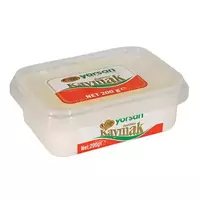Kaymak

Kaymak or ḳajmaḳ is a fermented milk food product that is quite difficult to give an unambiguous definition. Since kaymak can have the consistency of sour cream, butter or cottage cheese. In addition, soft kaymak cheese is made on the basis of a fermented milk product.
Among the professionals of culinary skills, there is an opinion that such a product as kaymak was invented by the inhabitants of the Balkan Peninsula. Until now, the Balkans have their own authentic kaymak production technology. It is noteworthy that the recipe and technology for the production of kaymak resembles another well-known fermented milk product called katyk.
In the process of making kaymak, cream is removed from milk for a sufficiently long period of time, which are laid out in layers in special clay containers. Then the cream is kept for several days in a warm room. As a result, a border is formed, which is distinguished by its dark cream or yellow tint.
In some countries, for example in Montenegro, salt is added to the border to improve the taste and consumer characteristics of the product. It is worth noting that similar in recipe, production technologies, as well as taste and consumer parameters of food can be found in the national culinary tradition of the countries of the Caucasus and the states of Central Asia.
For example, in Tajikistan, fresh whole cow's milk is used to produce kaymak, which is boiled for only a few minutes and then placed in a cold place. A day later, cream is removed from the surface of milk and served with baked homemade cakes. Researchers claim that kaymak was the first dairy food that they learned to make in Azerbaijan, as well as Tatarstan or Bashkiria.
In countries such as Romania and Moldova, kaymak refers to a layer of fatty milk foams that form on the surface of milk as a result of boiling. The useful properties of the border are primarily due to the vitamin-mineral composition of the product. The chemical composition of kaymak is enriched with vitamins of group A, B, and also N. In addition, kaymak contains such definitely useful compounds for the human body as calcium, iodine, molybdenum, phosphorus, as well as cobalt and potassium.
It is worth noting that the calorie content of the kaymak is at a fairly high level. This is primarily due to the high content of milk protein in the product. The average calorie content of the kaymak is at 750 Kcal, which are contained in 100 grams of the product. However, it is worth emphasizing that despite the high fat content, kaymak is considered an incredibly useful food for the human body.
In addition to the distinctive taste properties, the border has a number of other advantages. For example, eating kaymak regularly helps improve digestive and metabolic processes. In addition, kaymak helps to form a favorable microflora in the human stomach. The greatest benefit of kaymak will be brought to pregnant women, as well as young children during the period of active development and growth.
kaymaka 750 kCal
Energy value of kaymak (Ratio of proteins, fats, carbohydrates - ju):
Squirrels: 3.73 g (~ 15 kCal)
Fats: 22.83 g (~ 205 kCal)
Carbohydrates: 2.54g (~ 10kCal)
Energy ratio (bj | y): 2% | 27% | 1%
 Español
Español Français
Français Português
Português Русский
Русский 简体中文
简体中文 繁體中文
繁體中文 日本語
日本語 한국어
한국어 العربية
العربية Türkçe
Türkçe Қазақ
Қазақ Deutsch
Deutsch Italiano
Italiano Українська
Українська
